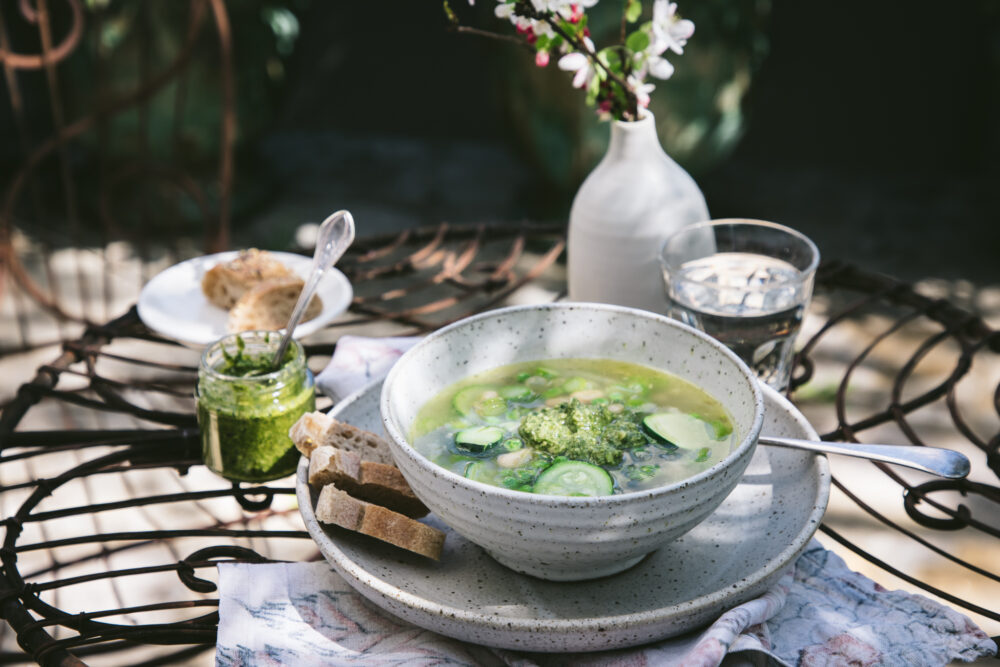Minestrone – the big soup
This spring minestrone with rocket pesto is a quick and easy soup to prepare. It’s made with a light chicken stock, a tin of cannellini beans and a few fresh vegetables – peas and asparagus which have just appeared again at the market – as well as eschalot and zucchini.
Minestrone literally means ‘big soup’ in Italian, thanks to all of the vegetables that are included. Minestrone comes from the Italian, minestra. It is derived from the Latin, minestrare, meaning to serve – generally food and drink – so it is a mix of ‘served soup.’
My favourite winter version is a recipe of Stephanie Alexander’s from ‘The Cook’s Companion,’ which takes more than an hour to cook. Her recipe includes dried borlotti beans, pork rind, parmesan rind, pasta, tomatoes, green beans and cabbage.
However, this spring minestrone takes a fraction of the time. With tinned cannellini beans, there’s no overnight soaking of beans required. It works works well with other green vegetables that benefit from cooking quickly, such as snow peas and sugar snap peas.
The rocket pesto can be made in advance, and then spooned on top of the soup, just before serving.
The origin of minestrone
When the Romans conquered Italy in the 2nd century BC, economic growth brought a wide variety of new vegetables to the market. Italian peasants began to make a soup from their leftover meals, using whatever vegetables were in season. Minestrone is part of what is known in Italy as cucina povera, meaning poorer people’s cuisine.
Due to its unique origins and the absence of a fixed recipe, minestrone recipes are wide and varied across Italy; they depend on traditional cooking times, ingredients, and season.
Minestrone ranges from a thick and dense texture with very boiled-down vegetables, to a more brothy soup with large quantities of diced and lightly-cooked vegetables that may include meats.
I did find a recipe for a barley and vegetable soup in Apicius, a Roman cookbook of the oldest known surviving collection of recipes. This recipe had a long list of vegetables and herbs, as well as chickpeas, lentils and split peas. It also had a little fish sauce, quite a common ingredient in Roman cooking, I note.
Pesto: making use of the whole vegetable

Pesto combinations
celeriac leaves with pine nuts
celery leaves with cashews
rocket and parsley leaves with walnuts or almonds
There are other versions of pesto that are red in colour – a reflection of their ingredients, such as sun dried tomatoes or red capsicums.
This rocket pesto was made with the last of the rocket in my herb garden. It was a little bitter, so I tempered it with some sherry vinegar. I know this isn’t a typical ingredient of pesto, but I think it worked well! All these pestos would go well with the spring minestrone.
You might like to try these sautéed greens with celery leaf pesto.
Best wishes,
Amanda
PS: If you’ve tried this spring minestrone with rocket pesto, or any other recipe from At Amanda’s Table, please let me know how it turned out in the comments below. And, if you’d like to read more, please subscribe to my monthly newsletter for stories, recipes and tips for simple, nutritious meals.
Spring Minestrone with Rocket Pesto
Ingredients
Spring Minestrone
- 1 eschalot, peeled and finely sliced I like to use a mandoline
- 2 cloves garlic peeled and chopped finely
- 1 zucchini, sliced
- 1 cup fresh peas, removed from their pods substitute with frozen peas
- 1 bunch asparagus, woody ends removed and thinly sliced
- 1 425 g tin cannellini beans, drained and rinsed
- 1 L chicken or vegtable stock
- 3 tbsp olive oil
- flaked sea salt and freshly ground black pepper
- rocket pesto, to stir in
Rocket Pesto
- 2 cups rocket leaves
- 1 cup Italian parsley leaves
- 1/2 cup olive oil
- 1/2 cup freshly grated parmesan cheese
- 1/2 cup walnuts
- 2 tsp sherry vinegar
- 1 clove garlic, peeled and chopped
Instructions
Spring Minestrone
- Heat the olive oil in a medium saucepan and sauté the sliced eschalot for 2 minutes until soft. Add the garlic and cook for another minute.
- Add the canellini beans and stock, bring to the boil, then add the peas, sliced asparagus and zucchini and simmer for 3 minutes. Do not overcook. You want the asparagus to have a little crunch.
- Season to taste and add a spoonful of the pesto on top. Serve immediately.
Rocket Pesto
- Mix the rocket and parsley leaves, garlic and olive oil in a large bowl briefly with a handheld blender or in a food processor.
- Add the parmesan cheese and walnuts and blitz briefly again.
- Stir in the vinegar. Season to taste.
- Store in a sealed jar in the fridge. Adding a layer of oil to the top of the pesto will help it maintain its bright green colour.
Notes


Leave a Reply